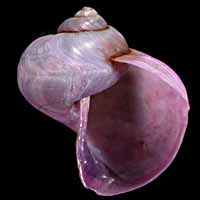|
< Previous family introduction |
|
|||||
 |
Family Janthinidae Violet snails
|
|||||
|
This is a small family of snails that float on the surface of the sea, supported by a bubble float made by the animal. The species occur worldwide in tropical and warm temperate seas, where they are distributed by wind and currents. There are only two living genera and less than 10 species in the family. The genus Janthina, the violet snails, has only five species, all with fragile, purple coloured shells. The genus Recluzia is poorly know but has only a few species, with fragile, brown shells. Janthina floats with the foot of the animal uppermost, attached to a float. The float is constructed from mucus secreted by glands on the foot of the animal enclosing bubbles of air. Many bubbles are joined together to form a raft up to about 120 mm in length. The front end of the animal, head tentacles, and mouth etc, are of normal caenogastropod organization, with the animal floating with shell aperture uppermost. The animals congregate in floating shoals of the "purple community" of coelenterates and molluscs, often a few kilometres across, but reported to be up to 200 miles across by Laursen (1953). The most common of the coelenterates in the floating community is the Portugese man-of-war, or bluebottle, Physalia ultriculus, which, with its purple float and long stinging tentacles is commonly washed up on NSW beaches. Another coelenterate member of the community is the smaller By-the-Wind Sailor, Velella velella, which is also commonly washed onto beaches. Living among, and feeding, on the coelenterates are the shelled molluscs Janthina and the shell-less nudibranch molluscs Glaucus and Glaucilla. Janthinids are protandric hermaphrodites; male first, then changing to female. There is no penis in the male, and sperm are transferred from male to female in packages. In Janthina exigua and J. pallida, fertilised eggs are held in capsules attached to the underside of the float of the female, and released as free-swimming larvae. In J. janthina, the eggs develop into veligers within the oviduct, rather than in external capsules, and released from there into the sea. A revision of Janthina was published by Laursen (1953). He reduced the large number of proposed species to five, based on studies of the radula, anatomy, and reproductive systems. However, Australian authors continued to use a variety of synonyms well after his work was published. For example, the NSW checklist published in 1962 (Iredale & McMichael, 1962) used none of the names established by Laursen as valid species. The pelagic molluscs of south-eastern Australia were described by Bennett (1966). Four of the five species of Janthina are found in NSW. They are most frequently seen as moribund animals in broken shells washed onto beaches after north-easterly summer winds. The fifth species, Janthina pallida Thompson, 1841, is known from northern Australia, but not from NSW (but erroneously reported from southern Australia by Wilson, (1993)). Family Reference Bennett, I. 1966. Some pelagic molluscs and associated animals in south-eastern Australian waters. Journal of the Malacological Society of Australia 1(9): 40-51. Laursen, D. 1953. The Genus Ianthina. Dana Report 38: 3-40. Coverage All species of the family known from NSW are treated here. Identification Notes Shells are easily placed in the genus Janthina by the fragile, violet-coloured shells. Species within the genus are distinguished by overall shell shape, surface sculpture, presence or absence of an umbilicus, and the shape of the sinus in the outer lip. |